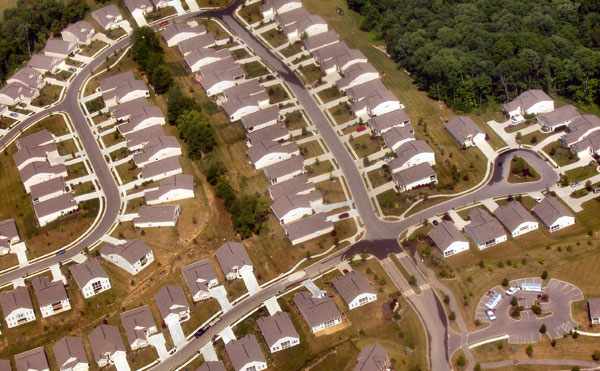The Return of the $1,000 Down Mortgage
“In today’s world, without question, we’ve learned two lessons,” FHA Commissioner David Stevens told reporters this winter. “One: homeownership is important to the sustainability of communities. And two: not everybody should own a home.”
Jul 31, 2020104.7K Shares1.8M Views
In Wisconsin and other states, home buyers might be eligible for 100 percent financing on mortgages. (Creative Commons.)
“Buy new with $1,000 down,” the advertisement says, the words resting atop a trim green clapboard house offset by a bright blue sky. “The time has come. Stop wasting rent check after rent check and start building equity in your own home. And with only $1,000 down, affordable monthly payments and no private mortgage insurance required, the dream is closer than you think.”
[Economy1] It sounds too good to be true. But it is true. This offer does not come from a subprime lender, looking to reel in thousands of unqualified and ill-advised homebuyers, only to slap them with add-ons, fees and variable rates. It is not a teaser or a trick. The advertisement references a program initiated by the National Council of State Housing Agencies and Fannie Mae, the taxpayer-backed, government-sponsored enterprise that buys up mortgages from lending banks.
The pilot program is called “Affordable Advantage,” and it has now been adopted by three states — Massachusetts, Wisconsin and Idaho. (Other states, such as Pennsylvania, California and Colorado, have similar state programs.) The initiative is small, reaching just a few hundred people so far. But it is looking to expand. Given the dangers of these types of mortgages and the specter of the housing bubble, where unconventional loans wreaked disaster, it is also raising questions from wary housing experts and legislators.
Fannie Mae helped to create Affordable Advantage after the state government agencies tasked with expanding homeownership found they were having trouble doing their job. Before the recession hit, these housing finance agencies, known as HFAs, issued tax-free bonds and used the funds on programs to encourage developers to build in underserved areas and to support single-family mortgages. When the financial crisis hit, private companies — leery of the collapsing housing bubble and freezing mortgage market — no longer wanted to buy the HFAs’ bonds. Their business ground to a halt.
To help HFAs move forward, Fannie Mae and NCSHA stepped in. Fannie Mae agreed to purchase mortgages with tiny down payments, as long as the homebuyers were vetted — had excellent employment histories and credit, and merely lacked a cash reserve for a down payment. And the participating HFAs agreed to buy back loans if they became delinquent, in lieu of Fannie asking for more-traditional mortgage insurance.
“[The program] was created to support state HFAs and their efforts to provide qualified first-time homebuyers with financing in the wake of the housing and economic downturn,” Janis Smith, a Fannie Mae spokesperson, says. “HFAs are nationally regarded leaders in affordable housing finance and their business is prudent, sustainable business. HFAs work closely with their borrowers to ensure they’re well prepared for homeownership. As a result, the loans delivered by HFAs have very low delinquency rates. In addition, HFAs work with first-time homebuyers who need and are qualified for affordable housing — a segment that has seen increased demand with the downturn in the housing market.”
Now, qualified homebuyers in the three states pioneering Affordable Advantage do not need to put down the 3.5 percent minimum down payment required by the Federal Housing Administration, or much of a down payment at all. They can get 100 percent financing — a loan as big as the purchase price of the house — for a 30-year, fixed-rate mortgage — a vanilla mortgage. The deal includes a program to help homebuyers if they become unemployed, lowered fees and there is no requirement that the homebuyer purchase mortgage insurance.
Wisconsin started the program first, in March, offering 100 percent loan-to-value mortgages for borrowers with a minimum credit score of 680. “It’s a good credit score,” explains Kate Venne, the spokesperson for the Wisconsin HFA. “In addition, we want to see what other lines of credit people have, and their performance. We look at their work history. We call their employers.” Thus far, Wisconsin’s HFA has offered $52 million in mortgages to 450 buyers.
But there are concerns and problems intrinsic to purchasing a home with almost no money down. First and foremost, if the housing market turns down even a fractional amount, the homeowner will go “underwater” immediately. If the price of the house falls by even a bit, he will owe more on the mortgage than the house is worth. If he needs to sell it, he needs to come up with extra cash to pay the bank back. And the fact that the homeowner only had a thousand dollars to put down in the first place implies that he does not have much financial breathing room and might default.
“That is clearly a worry,” says Barry Zigas, the director of housing policy for the Consumer Federation of America. “But for people who are buying a home first and foremost as a place to live, the fact there might not be much equity, or the equity might go negative — that’s not the most important feature.”
He argues that vetted low-income buyers have excellent track records in terms of default, as long as they are invested in their communities and have good employment and credit histories, if not savings. “The more equity you bring to your transaction, the more security you bring. But this can be a great way for people to gain access to homeownership who might not have been able to otherwise. And with mortgage rates what they are” — at historical lows — “this program lets those specific people gain mortgages.”
Others disagree. “Haven’t they noticed what’s happened to the country in the past five years?” asks Dean Baker, the co-director of the Center for Economic and Policy Research. “You’re not necessarily helping if you’re helping them buy a home where they’re in the position they won’t be able to afford it. I don’t understand the logic of this. House prices are still going to fall. And when they do, we haven’t helped these people who are going to have to work like crazy to pay their mortgage off, or they’re going to default. If you’re in a situation where this is the only mortgage you can get, you shouldn’t be buying a house.”
And many of the governments’ own economists believe that houses should not be many Americans’ primary investment. Karen Pence, who leads the Federal Reserve’s real estate finance research group, arguesthat homes are a terrible investment and believes the government should offer fewer programs and incentives to subsidize homeownership.
On top of that, Affordable Advantage raises questions since, at the end of the day, taxpayers are backing its investments — Fannie Mae being under the government’s conservatorship, and Treasury being the main purchaser of bonds from the state HFAs. In recent months, the government has turned away strongly from programs helping encourage mortgages with low down payments.
The Federal Housing Administration, for instance, considered a plan to let homebuyers use the Obama administration’s $8,500 first-time homebuyer tax credit to cover the 3.5 percent minimum required down payment. It received such push-back from the Hill, incensed the federal government would pay homeowners to have no skin in the game, and from housing experts, that the Department of Housing and Urban Development pulled the program. Indeed, faced with a 14 percent delinquency rate, the Federal Housing Administration increased the premiums it charges to insure some mortgages this year. And it set down payment requirements at 10 percent for borrowers with low credit scores.
On the Hill, increasing numbers of legislators want to ban mortgages with low down payments outright. Rep. Scott Garrett (R-N.J.) last year introduced legislation requiring FHA borrowers to put down 5 percent at least. This spring, Sen. Bob Corker (R-Tenn.) requested an amendment to the financial regulatory reform bill requiring minimum 5 percent down payments for private mortgages. Multiple legislators from both sides of the aisle have recommended looking at down-payment reform for Fannie and Freddie.
Low-income housing advocates argue that the state programs have much lower default rates than the national average, because the state HFAs had good track records of checking out prospective candidates and offering loans only to good ones. Kate Venne, of the Wisconsin HFA, says its default rate is just 1.83 percent. But more and more believe that the products are simply too dangerous, and that the government should no longer boost homeownership for Americans without the means to put at least 3.5 percent down.
“In today’s world, without question, we’ve learned two lessons,” FHA Commissioner David Stevens told reportersthis winter. “One: homeownership is important to the sustainability of communities. And two: not everybody should own a home.”
*Correction: *A prior version of this article misstated the name of the Federal Housing Administration, as the Federal Housing Agency. TWI regrets the error.

Hajra Shannon
Reviewer
Hajra Shannona is a highly experienced journalist with over 9 years of expertise in news writing, investigative reporting, and political analysis.
She holds a Bachelor's degree in Journalism from Columbia University and has contributed to reputable publications focusing on global affairs, human rights, and environmental sustainability.
Hajra's authoritative voice and trustworthy reporting reflect her commitment to delivering insightful news content.
Beyond journalism, she enjoys exploring new cultures through travel and pursuing outdoor photography
Latest Articles
Popular Articles
